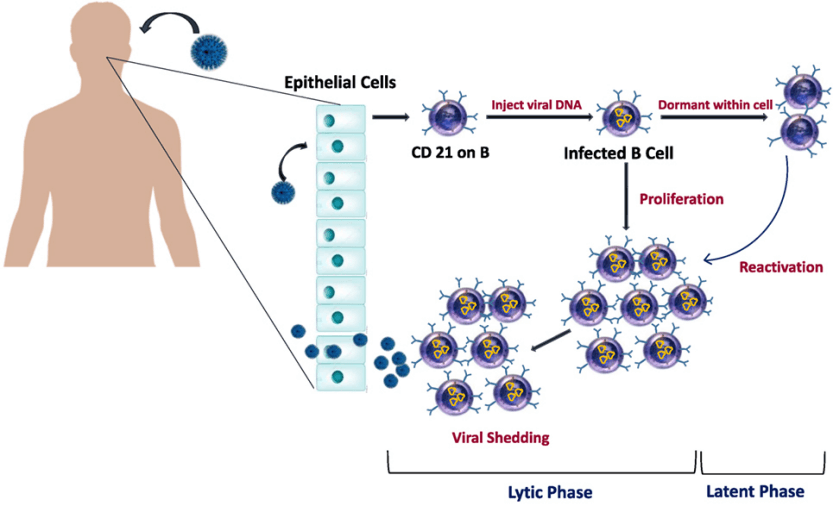Epstein-Barr Virus (EBV) is one of the most prevalent human viruses, as it affects more than 90% of adults in the world. Blood tests for EBV detect antibodies against EBV in the blood and help establish a diagnosis of EBV infection. Creative Diagnostics offers recombinant antigens p18 and p23 (Viral capsid antigens, VCA), p54 and p138 (Early antigens, EA) and EBNA1 (Nuclear antigen, EBNA). These recombinant antigens in immunoassays are suitable for the detection of IgG and IgM antibodies against EBV in blood samples.
Background
Epstein–Barr virus (EBV), also called human herpesvirus 4 (HHV4), belongs to the Gammaherpesviridae, genus Lymphocryptovirus. EBV can be spread through saliva, blood and semen, and usually causes infectious mononucleosis (IM). Some cases also show that this virus associates with several types of cancer and have a higher risk of certain autoimmune diseases. EBV has the ability to infect a very wide range of age of people. In the United States, about half of all five-year-old children and about 90% of adults have evidence of previous infection. The major cell types infected by EBV are epithelial cells and B cells. Once EBV's initial lytic infection is brought under control, EBV latency persists in the individual's B cells for the rest of the individual's life.
Table 1. Epstein-Barr virus (EBV) proteins and their functions (Houen G and Trier NH. 2021)

EBV contains a double-strand DNA about 172 kilobase pairs which encoding approximately 85 proteins. Epstein–Barr virus infects host cell and hence proliferates in it would experience four stages: an Entry to the cell by using viral glycoprotein gp350, lytic replication, latency and reactivation. In latency, only a few viral genes are expressed, which includes the six EBV nuclear proteins: EBNA-1, EBNA-2, EBNA-3A, EBNA-3B, EBNA-3C, EBNA-LP, and three latent membrane proteins: LMP-1, LMP-2A, LMP-2B.
 Fig. 1 EBV life cycle in healthy carriers (Smatti MK, et al. 2018)
Fig. 1 EBV life cycle in healthy carriers (Smatti MK, et al. 2018)
EBV specific serological assays, such as ELISA, EIA, IFA, chemoluminescence, and immunoblot, are the simplest way to test for EBV infection and for evaluating acute versus remote infection in healthy individuals. Among the proteins encoded in the EBV genome, several have been used for detection of antibodies to EBV including EBNA1, EBNA2, VCAp23, VCAp18, early antigen. Commercial immunoassays for detecting IgG and IgM against EBV are needed to detect at least three EBV antibodies: VCA-IgG, VCA-IgM, and EBNA-1 IgG, which are routinely used in combination to distinguish an acute from a remote infection. The presence of VCA IgM and VCA IgG without EBNA-1 IgG indicates a current acute infection, and the presence of VCA IgG and EBNA1 IgG without VCA IgM typically indicate a remote infection.
References
- Houen G, Trier NH. (2021). Epstein-Barr Virus and Systemic Autoimmune Diseases. Frontiers in Immunology. 11.
- Jha HC, Pei Y, Robertson ES. (2016). Epstein–Barr Virus: Diseases Linked to Infection and Transformation. Frontiers in Microbiology. 7.
- Smatti MK, Al-Sadeq DW, Ali NH, et al. (2018). Epstein–Barr Virus Epidemiology, Serology, and Genetic Variability of LMP-1 Oncogene Among Healthy Population: An Update. Frontiers in Oncology. 8.
| Target | Cat_N | Product Name | |
| Viral capsid antigen (VCA) | DAGA-3074 | Recombinant EBV p18 (BFRF3) Protein [His] | Inquiry |
| DAG1584 | Recombinant EBV p23 (BLRF2) Protein [His] | Inquiry | |
| Early antigen (EA) | DAG-T2771 | Recombinant Epstein-Barr Virus p54 [His] | Inquiry |
| DAG-T2772 | Recombinant Epstein-Barr Virus p138 [His] | Inquiry | |
| EBV nuclear antigen (EBNA) | DAG1578 | Recombinant Epstein-Barr Virus p72 (EBNA1) [His] | Inquiry |